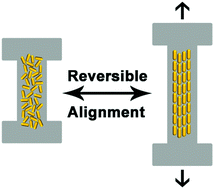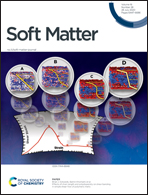Gold nanorod impact on mechanical properties of stretchable hydrogels†
Abstract
Double-network hydrogels have attracted much attention because of their superior mechanical properties, which are more similar to rubbers and soft tissues than classic hydrogels. In this report, plasmonic gold nanorods (AuNRs) were incorporated into a stretchable double-network hydrogel, composed of alginate and acrylamide. The impact of gold nanorod concentration and surface chemistry on bulk mechanical properties such as Young's modulus and elongation at break was investigated. AuNRs with three different surface chemistries, cetyltrimethylammonium bromide, thiolated poly(ethylene glycol), and 11-mercaptoundecanoic acid were successfully dispersed into alginate/polyacrylamide hydrogels. The AuNR-loaded hydrogels could be reversibly stretched, leading to AuNR reversible alignment along the stretch direction as judged by polarized optical spectroscopy. With the proper surface chemistry, hydrogel nanorod composites were able to be stretched to more than 3000% their initial length without fracturing. These results show that plasmonic gold nanorods can be well dispersed in multi-component polymer systems, certain surface chemistries can enhance the bulk mechanical properties, and AuNR orientation can be controlled through varying strains on the matrix.



 Please wait while we load your content...
Please wait while we load your content...
